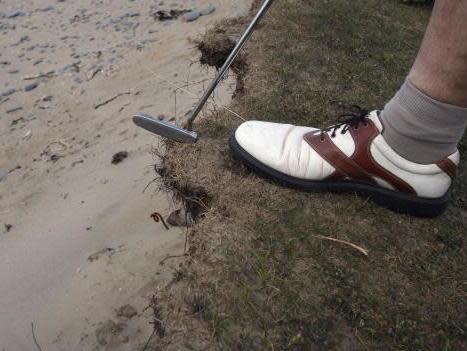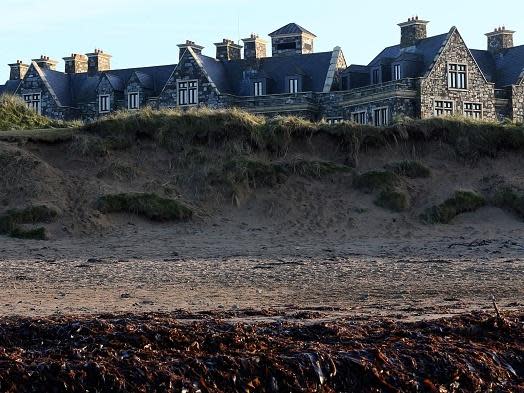St Andrews, Carnoustie and Donald Trump’s Doonbeg: The golf courses gasping for breath against rising tide
What if the world’s greatest golf courses steadily began to disappear? A vanishing act along the historic East Lothian way, a slow-motion mudslide from dune to ocean, fairways skidding inch-by-inch into the North Sea bed.
Coastal erosion, caused by rising sea levels and increasingly temperamental currents, has already claimed the celebrated 2nd and 3rd tees at Montrose Golf Club. Over £1m has been desperately splurged to save the world’s ninth oldest course, which has already lost 70m to its shore. At Royal North Devon Golf Club in the southwest, Christmas was spent submerged by floods and trowelling away tonnes of sand swept onto the second hole by Storm Deirdre. There, the eighth hole has already disintegrated immemorially into shingle beach. As many as one in six Open Championship courses, including St Andrews and Carnoustie, could feasibly be swallowed before the end of the century by the slightest rise in tides if intervention fails, but not before the wetter and warmer summers lure foreign diseases to their verdant grasses.
“I think every golf course around the world is going to be impacted by climate change to one degree or another,” the R&A’s director of sustainability, Steve Isaacs, tells The Independent.
“The greater extremes in weather that we’ve seen and the predictions for things like rising sea levels are something we haven’t faced before. The last few years, one of the biggest aspects of a changing climate has been more frequent storms blowing over the Atlantic. That can cause the blowout of dune systems, particularly in high tides. Courses are going to be challenged. And that’s not just coastal courses, there are inland courses as well that will have heavier levels of rainfall and prolonged periods of drought down in southeast England.”
The access road that winds from Brancaster village to Royal West Norfolk Golf Club has flooded on any given day for hours during tidal surges for the best part of two decades. The angry, unstopping waves of the North Sea have prospered through austerity, catapulted by a near-relentless chime of northerly wind. During a perfect storm, it could steal beach by the metre.
Through a series of wrangling experiments, the club first ventured the possibility of piling up flint as means of a barrier to protect the strangled sand dunes, before eventually commissioning 20 well-wishing locals to string geo-textile mesh around the base of the dunes to trap loose sand and form a sheer incline. Meanwhile, The Environmental Agency haplessly attempted to build a 60m breach in the coastal sea defences to the west of the clubhouse to relieve pressure on the dunes.
Each effort came to no avail. In 2013, the bank burst open in five places and only the weathered facsimile of the main dune prevented the golf club from being devastated entirely. Three tractors and seven ride-on mowers were amongst the £600,000 worth of machinery destroyed by the flooding. Damage to the clubhouse forced the course to close for three weeks and suffer losses of over £1.2m in total.
“Being situated where we are,” Tim Stephens, the secretary of the golf club, says, “it’s just the fabric of the place. I think it’s well recognised you can’t stop it. The number of times the road floods is increasing year-on-year. It’s obvious that it’s not getting any easier and we invest all that we can in defences to prevent the type of losses that were incurred.

“We’ve got special protection for all the doorways and any openings [at the clubhouse] to well above a metre high and we’ve got a disaster plan in place so we know what to do if we get a flood alert from the Environment Agency or if there are flood warnings.”
What also prevents one of England’s most prestigious red-trousered links from barricading itself against the sea is an estranged relationship with conservation areas. Wriggling amongst the morphing dunes and thickset fescue, its protected status means the likes of rock armour – which is currently only used in small increment – and other artificial methods of combatting the effects of climate heating are not permitted, leaving an exhaustive and, thus far, largely fruitless search for an organic solution.
At Donald Trump’s Doonbeg Golf Course along the Wild Atlantic Way in southern Ireland, a 50-hectare conservation area and a minute mollusc have impeached the president’s profiteering. After buying the course for a cut-price – owing to a family dispute and urgency to sell – Trump sought planning permission to build a 38,000 tonne rock-barrier to protect three holes at the course from being eaten away by the Atlantic Ocean “as a matter of urgency” – sensing no fickle hint of irony as his representatives referenced the impacts of climate heating in his application.
The nub of Trump’s intention lies in the fact that the R&A designate that an Open Championship course must be able to provide a permanent topographical map. A lack of protection means the dunes are subject to rapid and unpredictable alterations so Doonbeg cannot meet those standards, thereby lacerating its reputation and potential revenue stream.
The course’s luxury hotel had brought a wealth of jobs to the village and locals were virtually unified in favour of giving the wall a cobble green light. But fighting the lowly one-man battle, Tony Lowes, Chairman of the Friends of the Irish Environment and a veteran environmentalist campaigner objected to Trump’s proposal due to an EU designated conservation area on the shore of the beach that guarded a rare two-millimetre-long breed of whorl snail.
“When Trump bought the place he was determined that he would stop the erosion because it was getting quite serious on a couple of the holes,” Lowes says. “His workers just rolled up with big limestone boulders. The seawall was so clearly against the [conservation area’s] objectives.”

Trump then withdrew the application, after threatening to hold the state responsible for losses, and was eventually given permission by County Clare to build two 2,067ft and 853ft seawalls on a public beach. “As our scientists have pointed out, that doesn’t work either because you just get a pull of sand and have to defend the next bit,” Lowes says exasperatingly.
“They say they can’t run a viable golf course, Is the environment compatible with golf courses? Yes, but not under those conditions.”
The case rumbles on. Doonbeg is still a far cry from becoming an Open Championship certified course. Lowes is confident his appeal against the second wall will be upheld by European Law.
The impact of coastal erosion on golf is unprecedented and increasingly prevalent as the relationship between the sport and nature edges towards divorce. Others, though, are attempting to renew golf’s vows with the environment.
On Martha’s Vineyard, a Massachusetts island just south of Cape Cod, home to billionaires and setting to romantic whisk away novels, a 230-acre botanical experiment is thriving. Opened in 2002, Vineyard Golf Club is the world’s first all-organic golf course and doesn’t use a single synthetic pesticide, fertiliser or any type of artificial chemical. The team of staff – all college graduates with degrees in the biochemistry – work closely with Cornel University and the course’s superintendent, Kevin Banks, describes it lovingly as “like one giant experiment plot”.

Sustaining an organic golf course is a far greater and dearer challenge. Some of the chemicals Banks wants to test on the area of the fairway to clear weeds or nourish the grasses can take up to three months to arrive. “Nobody else in the world is trying to buy it,” he says, with the undertones of a botanical drug smuggler. “These are some products you just don’t get on the shelves.”
Banks also relies on the island’s wildlife. The large skunk population eat away at unwanted grubs and he buys specific nematodes to attack other unwanted vegetation in the soil. Bluebirds chirp and pirouette on the flanks of each fairway – there are two boxes built specially on every hole – and help to deter mosquitos, while lavender and cedar oils smog out the tics. Banks has even been in discussion to hire goats to eat away at the poison ivy.
“The hardest thing about managing an organic course is it’s very weather dependent,” Banks says, “and it’s definitely not cheap. The last four summers have been abnormally warm and humid and we get a lot of weeds we haven’t seen before. We have some organic products to control patches, liquid iron for the clovers that get too big, but sometimes we just have to spend the day stripping it by hand and replanting it. Luckily, we’re a financially stable club so I’m usually able to get organic products in once a week, but if you didn’t have a big budget, the course’s condition would take a huge hit.

Nevertheless, hundreds of horticulturists, botanists and scientists visit the Vineyard each year, looking at ways to follow suit, and Banks knows that members of his team will soon leave to run their own organic sites. “It’s really cool we’re starting to make a trend, especially with sports fields in America,” he says. “I know some clubs are going 50/50 now where they’ll only treat the greens artificially. It might take a long time [to achieve] but things are definitely turning that way.
Golf is attempting to deter its impact on climate heating in other more scripted ways. Numerous clubs across the globe are installing solar panels, such as at Candler Hills in Florida, where 297 photovoltaic panels glaring atop the maintenance building produce enough energy to manage the entire course, as well as reimbursing back into the electric grid. After a decade, the panels should have saved the club over $200,000 in electrical costs.
On one front, golf is attempting to fight against nature, on another it’s attempting to intertwine. The danger to courses such as St Andrews, Royal Troon and Carnoustie remains at large. The progress towards an organic front remains slow and sceptical. But will the game’s forces combine to find a balance before it’s too late, to reel the world’s great golf courses back from the clutches of disaster? “Golf has been working with a changing climate for centuries,” says Isaac. “It’s not new, but the greater extremes in weather we’ve seen recently are novel. The future predicts something we haven’t faced before.”

 Yahoo News
Yahoo News 